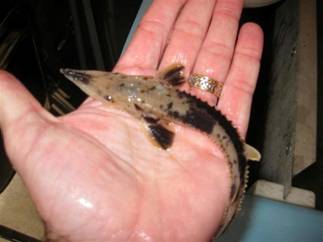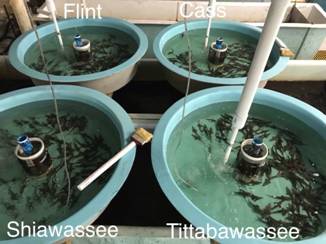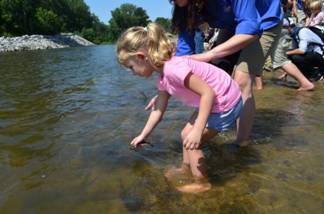Saginaw Bay Sturgeon Restoration Receives Grant to Stock Iconic Lake Sturgeon

The Conservation Fund and the Bay Area Community Foundation has presented Sturgeon For Tomorrow Black Lake Chapter with an $8,000.00 grant to purchasing food for lake sturgeon at the Black River Sturgeon Facility and associated expenses with raising lake sturgeon in preparation for release into the Saginaw Bay Watershed rivers : Cass, Tittabawassee, Shiawassee, and Flint.
“The efforts to restore the Saginaw Bay lake sturgeon population began in the 1990s with habitat restoration efforts, dam removals, and education. Beginning in 2018, a broad partnership of agencies, nonprofit organizations, schools and more, took the first step of releasing juvenile lake sturgeon”, said Michael Kelly, Director of the Great Lakes Office of The Conservation Fund and the Saginaw Bay Watershed Initiative Network (WIN).
“Ensuring the diversity of animal life and protecting water quality are important issues to the Bay Area Community Foundation. Seeing the population of this historic creature rebounding in our river system is especially gratifying. We are proud to support the efforts of The Conservation Fund and all of the partners that are working to bring lake sturgeon back home”, said Diane Fong, CEO of the Bay Area Community Foundation.
For decades the Black Lake Chapter of Sturgeon For Tomorrow have invested in lake sturgeon recovery. “This grant will assist us with off-setting costs of food for rearing the sturgeon to be stocked in the Saginaw Bay Watershed”, said Brenda Archambo President of Sturgeon For
Tomorrow Black Lake Chapter. “The goal for this grant is to stock out 500 fall fingerling lake sturgeon per year in the Saginaw Bay Watershed over the next three years”, Archambo said.

After studies in Black, Burt, and Mullett lakes showed that the sturgeon reared in the MSU operated Black River streamside hatchery and stocked in those lakes had higher than expected survival, stocking rates were decreased in those waters. This action made some fish available
for sturgeon rehabilitation efforts elsewhere. “We chose to prioritize the Saginaw River system for the next sturgeon rehabilitation effort because it historically had a sturgeon population, and there was tremendous local interest in rebuilding that population,” said Dave Borgeson DNR Fisheries manager for the Northern Lake Huron Management Unit. “Of course, our ability to stock the desired amount of sturgeon is always dependent on successfully getting fish into the hatchery and rearing them, and that can vary from year to year,” Borgeson said, “but the people at MSU have done a great job in consistently rearing the targeted number of healthy fish under highly unpredictable and varying conditions.”
“Since stocking began in the Saginaw River Basin in 2017, we are now beginning to regularly receive reports of juvenile sturgeon being incidentally caught by walleye anglers in the Saginaw River and Saginaw Bay – mostly during the winter ice fishing season. The anglers have been pretty excited to accidentally catch a rare fish and for many it is the first time they have caught one. They typically snap a photo before quickly returning the fish to the river. For us, it is exciting and encouraging to know that obviously many of our stocked sturgeon are surviving and residing in the river and bay,” said Jeff Jolly DNR Fisheries manager for the Southern Lake Huron Management Unit.
The 2021 sturgeon release events are tentatively for scheduled for August 20 at sites along the Flint, Cass, Tittabwassee and Shiawassee Rivers.




